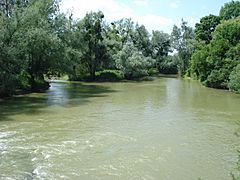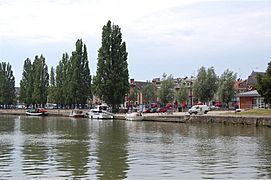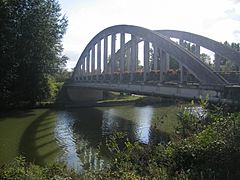Aisne (river) facts for kids
Quick facts for kids Aisne |
|
|---|---|
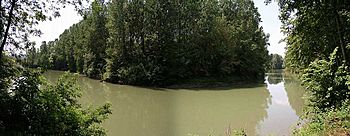
The Aisne near the village of Soupir
|
|
| Country | France |
| Physical characteristics | |
| Main source | Champagne-Ardenne 48°56′44″N 05°10′46″E / 48.94556°N 5.17944°E |
| River mouth | Oise 49°26′1″N 2°50′49″E / 49.43361°N 2.84694°E |
| Length | 356 km (221 mi) |
| Basin features | |
| Progression | Oise→ Seine→ English Channel |
| Basin size | 7,752 km2 (2,993 sq mi) |
| Tributaries |
|
The Aisne is a river in northeastern France. It is a tributary (a smaller river that flows into a larger one) of the Oise river. The river gave its name to the French department of Aisne. Long ago, in Roman times, it was known by its Celtic name, Axona.
Contents
About the Aisne River
The Aisne river is about 355.9 km (221.1 mi) long. Its drainage basin (the area of land where all the water drains into the river) covers about 7,939 km2 (3,065 sq mi). This means it collects water from a very large area!
Where Does the Aisne Flow?
The Aisne river starts in the "Forest of Argonne." This is in the Rembercourt-Sommaisne commune (a small local area) in the Meuse department. The river begins at a height of about 240 m (787 ft). From there, it flows towards the west.
The Aisne river travels through two main regions and five different departments in France. Some of the towns it passes through include:
- In the Grand Est region:
- In the Hauts-de-France region:
- Aisne: Neufchâtel-sur-Aisne, Vailly-sur-Aisne, Soissons, Vic-sur-Aisne
- Oise: Attichy, Trosly-Breuil, Compiègne
The Aisne river finally joins the Oise river in the city of Compiègne.
Rivers Joining the Aisne
Many smaller rivers flow into the Aisne river. These are called tributaries. Here are some of the main ones:
|
Rivers joining from the left:
|
Rivers joining from the right:
|
How Much Water Does the Aisne Carry?
The average amount of water flowing through the Aisne river each year is called its discharge. At Trosly-Breuil in the Oise department, this is about 65.40 m3/s (2,310 cu ft/s). This measures the volume of water that passes a certain point in the river every second.
Average monthly discharge (m3/s) at Trosly-Breuil (1961 - 2002)
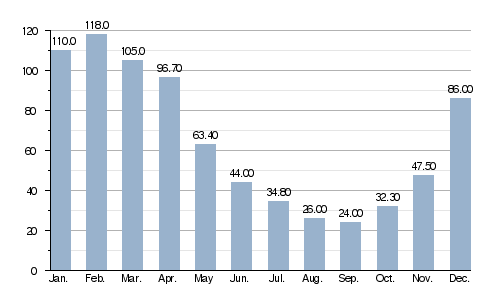
The chart above shows how the amount of water in the Aisne changes throughout the year. The river has typical seasonal changes. The highest water levels are usually in winter and spring, from December to May. February often has the most water. The water level then drops quickly during the drier period, which lasts from July to October.
Gallery
-
Aisne river at Soissons
Related pages
Images for kids
-
German trenches along the Aisne during World War I
-
The Aisne running through Soissons
See also
 In Spanish: Río Aisne para niños
In Spanish: Río Aisne para niños



